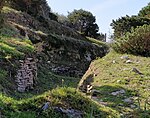Cabo da Roca Lighthouse
Houses completed in 1772Lighthouses completed in 1772Lighthouses in PortugalTowers completed in 1772

The Cabo da Roca Lighthouse (Portuguese: Farol do Cabo da Roca) is a beacon/lighthouse located 165 metres (541 ft) above the Atlantic Ocean, on Portugal's (and continental Europe's) most westerly extent. It is located in the civil parish of Colares, in the municipality of Sintra, situated on a promontory made up of granite boulders and interspersed limestone. It is a third-order lighthouse, which originally began operating in 1772. It was the first new purpose-built lighthouse to be constructed in the country; the older lighthouses in existence at that time were constructed on existing platforms or from pre-existing beacons.
Excerpt from the Wikipedia article Cabo da Roca Lighthouse (License: CC BY-SA 3.0, Authors, Images).Cabo da Roca Lighthouse
Estrada do Cabo da Roca,
Geographical coordinates (GPS) Address External links Nearby Places Show on map
Geographical coordinates (GPS)
| Latitude | Longitude |
|---|---|
| N 38.782 ° | E -9.4973333333333 ° |
Address
Farol do Cabo da Roca
Estrada do Cabo da Roca
2705-001 (Colares)
Portugal
Open on Google Maps











